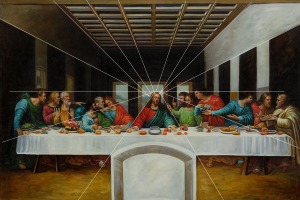Perspective is the way in which objects appear to the eye based on their position, dimensions and spatial attributes. Perspective drawing is an art technique used to represent three-dimensional images on a two-dimensional plane. There are two main terms within the concept of perspective: linear perspective and aerial perspective.
Linear perspective refers to the size and proportions of objects represented in a space, for example as objects become more distant they appear smaller because their visual angle decreases. Perspective is also seen in the way the parallel lines (viewed at a certain angle) appear to meet at a distant point, the vanishing point. This point lies on a line, called the geometrical horizon, at the level of the viewer’s eye.
“The Last Supper” by Leonardo Da Vinci has many linear perspectives caused by the buildings architecture as well as the people, that point towards Jesus, bringing more focus to him.
Aerial perspective deals with atmospheric effects on tones, colours and the general appearance of an object as it is viewed from a distance. As the distance between an object and the viewer increases, the clarity between the object and its background decreases. What’s more, objects that are closer to the foreground possess more detail than objects seen further away. The colours of the object also become less saturated and shift towards the background colour: blue.
“Blue Ridge, Parkway Series” by Janet Wimmer portrays the effects of aerial perspective by giving the hills a blue tint the further they become.

